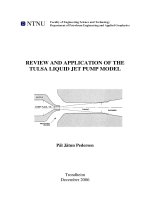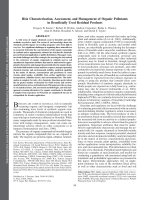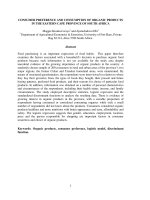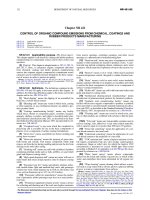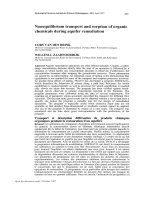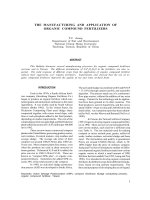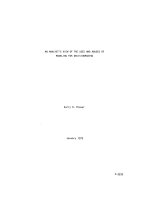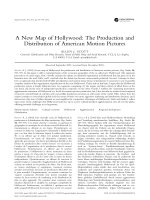THE MANUFACTURING AND APPLICATION OF ORGANIC COMPOUND FERTILIZERS pot
Bạn đang xem bản rút gọn của tài liệu. Xem và tải ngay bản đầy đủ của tài liệu tại đây (198.94 KB, 9 trang )
1
THE MANUFACTURING AND APPLICATION OF
ORGANIC COMPOUND FERTILIZERS
T.C. Juang
Department of Soil and Environment
National Chung Hsing University
Taichung, Taiwan, Republic of China
ABSTRACT
This Bulletin discusses several manufacturing processes for organic compound fertilizers
overseas and in Taiwan. The different formulations of N-P
2
O
5
-K
2
O in the fertilizers are also re-
ported. The yield response of different crops from the application of organic compound fertilizer
reflects their superiority over organic fertilizers. Experiments also showed that the use of or-
ganic compound fertilizers improved the quality of tea and some orchard fruits.
INTRODUCTION
Early in the 1970s, a South African fertil-
izer company (Groeikrag Organic Fertilizers Co.)
began to produce an organic fertilizer which con-
tained guano and ammonium carbonate as the main
ingredients. It was widely used by South African
farmers (Botha 1982). In the United States, the
Dickerson Composting Plant used sludge slurry
composted together with coarse wood chips, with
lime or rock phosphate added to the final product,
depending on market requirements. The cost of the
composting system was quite high, and the Dickerson
plant suffered a net loss of U.S.$7 million per 100,000
mt in 1982.
There are now many commercial compost
plants in the United States, processing poultry wastes,
corn residues, livestock manure, crop residues and
sewage sludge. The average sale price of their
compost was around US$25-30/mt, plus US$5 de-
livery cost. Most compost plants lose money, even
when the products are used in plant nurseries or
home gardens. If chemical N, P and K is added, the
price can rise to US$31-50/mt F.O.B These are
known as “compost-NPK plus”, or organic com-
pound fertilizers. Sometimes the added NPK ex-
ceeds 38% of the total present in the compost.
In 1990, an activated sludge pasteuriza-
tion process (ASP) was developed in South Africa.
The activated sludge was enriched with N and P (N:P
= 11:18%) through natural aerobic and anaerobic
digestion. The process made use of a continuous-
flow pipe reactor, without the addition of any extra
energy. Patents for the technology and its applica-
tion have been granted in 23 other countries. The
final product is used in liquid form, and the cost is
about US$30 - 45 per wet ton and US$180/mt for the
dried solids. An evaluation report has been submit-
ted by Nell, van der Merwe and Barnard (Nell et al.
1990).
In Taiwan, the Taiwan Fertilizer Company
(TFC) began to develop organic compound fertiliz-
ers in 1986. There are now seven formulated fertil-
izers on the market, each used for a different crop
(see Table 1). The raw materials used for making
compost or mixer include peat, guano, milled oil
seeds, leather residues, activated sludge and bone
meal. The formulation and quality is guaranteed.
Prices are around US$326-544/mt, which is 30-
100% higher than the price of ordinary compost.
Juang and Tsai have formulated a number of differ-
ent compound organic fertilizers made from various
organic wastes to which a small amount of NPK
fertilizer has been added (Tsai 1995, Juang and Tsai
1996). It is intended to develop organic compound
fertilizers for different crops from different formula-
tions, based on crop nutrient requirements. The
three main purposes of developing the use of organic
Keywords: Active Sewage Pasteurization (ASP), compost, Dickerson Sludge composting process,
organic compound fertilizer, Taiwan
2
compound fertilizers in Taiwan are:
• To cut down the cost of applying com-
post (less compost is needed);
• To reduce nitrate pollution from chemi-
cal fertilizer; and
• To meet the different nutrient require-
ments of various crops.
There are more than 100 private compost
factories in Taiwan, producing all kinds of organic
fertilizers. Since they are not covered by official
regulations, their quality control is generally poor.
They tend to contain variable amounts of chemical
N, P and K. The nutrient balance does not usually
correspond to the needs of the crop, and they are
generally sold for too high a price.
The following sections discuss the pro-
cesses by which organic compound fertilizers are
manufactured, both in Taiwan and abroad, and re-
port on the yield or quality responses of crops from
the application of these fertilizers.
MANUFACTURING PROCESSES FOR OR-
GANIC COMPOUND FERTILIZERS
Dickerson Sludge Composting Process
Coarse wood chips are spread out by a
bucket loader in long rows with flattened tops.
Tankers containing sludge slurry drive slowly along
the rows, discharging slurry as they go. The slurry
and wood chips are mixed roughly by a bucket
loader, while a Cobey machine then picks up the
mixture and forms it into a hollow square. At the
same time, another operator prepares a bed of wood
chips over slotted plastic pipes. The mixed material
is then laid over the layer of wood chips, allowing
proper removal of the air. A final layer of compost
is laid over the top of the fresh material. Simple
suction pumps of only 1/3 H.P are used to expel the
air from each unit. The air is pumped into a small
compost heap to absorb any volatile odor. Tempera-
tures in the compost heap rise to 70°C, or even 90°C,
and all pathogenic organisms are destroyed. The
material is screened after three weeks. The screening
machine is movable, and has two rubber screens, the
upper with 2-cm square holes, and the lower with 1
cm mesh. In smaller units, wire string screens are
used. Coarse wood chips are used again for the
composting process, since they facilitate aeration.
The final product is piled in heaps
7-10 m high, using a stacking conveyer.
Lime or rock phosphate may be added,
depending on market requirements. One plant
produces 100,000 mt annually.
Active Sewage Pasteurization (ASP)
Process
(Note: Patent granted in South Africa in 1989)
Water is removed from primary or digested
sewage sludge by conventional methods until it is
15% solids. The concentrated sludge then enters a
stainless steel pipe reactor. The retention time
varies, depending on flow rate (Fig. 1), but ten
minutes is normally sufficient. At the point where the
sludge enters the reactor, anhydrous ammonia gas is
injected into the sludge at a pressure of 100 - 300
kpa, although 200 kpa is typical.
As a result of the exothermic reaction be-
tween the ammonia and the sludge, the temperature
in the reactor rises to 40°C - 50°C. The actual
temperature depends on the pressure, the quantity of
ammonia injected, and the flow rate. The pH is
normally 11.6. Just before the sludge leaves the pipe
reactor, concentrated phosphoric acid is pumped
into the ammoniated sludge at a rate sufficient to
reduce the pH of the mixture to 7.0. Depending on
Table 1. Commercial organic compound fertilizer in Taiwan
Formulation Crop
NP
2
O
5
K
2
O MgO Compost
11 - 11 - 11 30
5 - 10 - 10 - 5 30 Orchards, vegetables
10 - 6 - 7 - 3 30 and rice
15 -3 -7 -3 30
5-10-10-5 30
5 - 15 - 15 - 30
5 - 10 - 15 - 3 30 Tobacco
3
Fig. 1. Schematic Diagram of the ASP process
residual temperature and ammonia concentration, a
further temperature rise to 65-75°C is obtained.
The treated sludge then enters a heat
exchanger where heat is transferred to the
incoming untreated sludge and/or ammonia.
Pasteurization is achieved by a combination of
pressure, temperature, pH and ammonia
toxicity.
Pressure in the pipe reactor is controlled
by throttling the outflow, while retention time
is determined by the throughput rate. The
final pH depends on the ratio of ammonia to
phosphoric acid pumped into the system.
Temperature control is less straightforward,
since it depends on both the total amount of
ammonia injected and the ratio of ammonia to
phosphoric acid.
The end-product is a syrupy, gray to
black liquid with a slight ammonia smell.
The intensity of the smell is related to the
pH, the concentration of free ammonia and the
ratio between the ammonium phosphate species
present. As more phosphoric acid enters the
system, the ratio of di- to mono-ammonium
phosphate decreases, with a simultaneous fall
in the concentration of free ammonia, in pH
and in the solubility of the ammonium
phosphate.
The process can be carried out in a
modular plant, each module having a daily
capacity of 20 - 60 million liters.
TFC Special No. 4
The Taiwan Fertilizer Company (TFC) has
manufactured a 8-8-8-3-50 (Compost) organic com-
pound fertilizer, known as ‘Special No. 4’ or by its
commercial trade name of “Humic Acid Organic
Compound Fertilizer”. The raw materials include
peat, guano, and chemical nutrients such as urea,
mono-ammonium phosphate, potassium sulphate,
KOH and Mg(OH)
2
. The manufacturing process is
shown in Fig. 2. TFC Special No. 4 contains 12.0%
humic acid and 50.0% organic matter, and has a pH
of around 7. It is sold in both powder and granule
forms. This fertilizer is suitable for use in orchards
and tea plantations, and for vegetables, rice and
flowers.
TFC Tobacco Organic Compound
Fertilizers
In 1993, TFC developed two formula-
tions of organic compound fertilizer, 5-15-15-
30 and 5-10-15-3 (MgO)-30, specifically for
tobacco. The raw materials include bone
4
Fig. 2. Diagram of manufacturing process of TFC Special No. 4
meal, linseed and rapeseed meal, mono-
ammonium phosphate, potash sulphate and
urea. The production process is shown in
Fig. 3. The 5-15-15-30 fertilizer is
recommended for use in central and eastern
Taiwan, and 5-10-15-3-30 for use in southern
Taiwan. The fertilizer takes the form of
rounded crystals. Another TFC organic
compound fertilizer, 11-11-11, is widely
recommended for use in orchards, tea
plantations and vegetable farms. One of the
raw materials of 11-11-11 is powdered leather
scraps, which contain amino acids and
ammonium-type nitrogen which may have
some beneficial effects on crops.
Experimental Pilot Plant
A pilot organic fertilizer plant has been built
at the Taichung District Agricultural Improvement
Station in Taiwan (Tsai 1995). Here, organic fertil-
izer are being manufactured from different combina-
tions of raw materials, with or without urea and
superphosphate. The animal wastes include chicken,
cattle and hog manure used as a primary source, to
which is added sawdust, rice straw or mushroom
compost (i.e. Compost which has been used for
intensive production in mushroom houses.) In some
cases, urea and superphosphate are added before
composting. The manufacturing process is shown in
Fig. 4. It follows a complete composting procedure.
The compost is then screened, granulated, and finally
packed.
5
Fig. 3. Diagram of the manufacturing process for TFC tobacco
organic compound fertilizer
CROP YIELD RESPONSES TO ORGANIC
COMPOUND FERTILIZERS
Corn
The use of organic compound fertilizer
in corn production is not economical, because
the price for the crop is too low compared to
the cost of the fertilizer. However, there are
some reports that the use of fertilizer from the
ASP process in South Africa produced yield
increases in corn and tobacco of 20 - 30%
(A. Fourie, personal communication 1992).
Tobacco
Experiments were conducted in three
sites in Taiwan, in the center, east and south
of the island, respectively. They compared
the effect of two organic compound fertilizers
and two chemical fertilizers on the spring and
autumn tobacco crop. The organic compound
fertilizers were made by the Taiwan Fertilizer
Company (5:15:15 (30) and 5:10:15:3 (30)),
while the NPK chemical fertilizers were
7:21:21 and 9:18:27. Both kinds of fertilizer
were applied at N-levels of 40, 60 and 80 kg
N/ha.
6
Fig. 4. Manufacturing process for organic compound fertilizer made from
composted livestock manure.
7
Table 2. Comparative yield of tea (g/plant) from the application of organic and inorganic compound fertilizers, Taiwan 1993
8
The results showed that in the first year,
tobacco quality was better from the heaviest
organic compound application in eastern
Taiwan, but there was no significant difference
in yield between the two fertilizer treatments.
During the second year (1995-96), the organic
compound fertilizer at a level of 60kg N/ha
was found to give a higher net profit for
autumn tobacco in Taichung. As one might
expect, the yield increased with increasing N
levels for both chemical and organic compound
fertilizers. However, the use of organic
compound fertilizers for tobacco production
gave higher yields than chemical fertilizer at
the same N levels, although this effect was
not seen until the second year.
Tea
The Taiwan Tea Experiment Station
conducted field trials on the effect of organic
compound fertilizers in two sites in Taiwan in
1993. The results in tea yield (g/plant) are
shown in Table 2. The yield increases from
the use of organic compound fertilizer seems
quite significant, especially in site No. 1. Tea
to which organic compound fertilizer 10-6-7-2-
30 had been applied appeared to have better
flavor and fragrance.
Rice
Rice field experiments were conducted in
three sites in the lowland plain of central
Taiwan (Juang and Tsai 1996). The
treatments were designed according to a
formulation of 12-18-12 (40) for rice as
follows:
All treatments of total N, P
2
O
5
and
K
2
O maintained the same level of 120-180-
120 levels. Application of compost assumed
50% available N in composted hog and
chicken manure and mushroom wastes, and
25% available N in composted cattle manure
and mushroom wastes. Chemical P and K
fertilizers were added make up the unsufficient
P
2
O
5
and K
2
O in the compost treatments.
The results indicated that chemical
fertilizers gave the highest rice yield (Table
3). They also showed that organic compound
fertilizer gave higher yields than compost
alone.
Citrus
Experiments carried out at the Taiwan
Tea Experiment Station on Ponkan oranges in
1993, using organic and chemical compound
fertilizers, found that the former gave a higher
Brix, and in some cases a higher yield.
Experiments on pommelo at the Tainan
District Agricultural Improvement Station,
Taiwan, gave similar results.
Vegetables
Some experiments on the use of organic,
organic compound and chemical fertilizers for
green onion have been carried out in Taiwan
at the Hualian District Agricultural
Improvement Station. Fertilizer applications
were adjusted in order to make up the same
level of N-P
2
O
5
-K
2
O (180-100-160 kg/ha).
These experiments are still at an early stage,
but so far they have shown yields from plots
with organic compound fertilizer to be higher
than those with chemical fertilizer.
Similar results have been obtained with
comparable experiments on lettuce, comparing
chemical fertilizer treatment with two types of
compost and three organic compound
fertilizers. Although the highest yield was
obtained with a compost treatment, the
chemical fertilizer treatment gave a higher
yield than the organic compound fertilizer or
the other compost treatment.
CONCLUSION
Organic compound fertilizer may
combine the best qualities of compost and
chemical fertilizer, in a way which is cost
effective and minimizes environmental
pollution. However, the quality control of
organic compound fertilizer and of compost
are of critical importance. National standards
for factories and for the quality and prices of
products, should be set by the government,
and included officially in Taiwan’s Fertilizer
Management Law.
9
Table 3. Effect of compound and organic fertilizers on rice yields at three lowland sites,
central Taiwan
REFERENCES
Botha, A.D.P 1982. Report on a study tour
of the United States of America. Institute
of Soil, Water and Climate, South Africa.
(Unpublished mimeograph).
Chen, H.T. 1995. Field organic fertilizer test
of lettuce. Annual Report, Taichung -
District Agricultural Improvement Station.
Taiwan ROC. (In Chinese).
Chiang, J.K., M.C. Huang and S. Yao. 1992.
The effects of bark-compost on the quality
and yield of the spring tobacco crop.
Bulletin Tobacco Research Institute 37: 1-
7. (In Chinese).
Cho, C.Y. 1995. Field organic fertilizer test
of pomelo fruit. Annual Report Tainan
District Agricultural Improvement Station.
Taiwan ROC. (In Chinese).
Liu, C.L. 1994. Evaluation of the response
of organic compound fertilizer on the
yield and quality of flue-cured tobacco.
Annual Report, Taiwan Tobacco Research
Institute, pp. 119-126. (In Chinese).
Liu, C.L. et al. 1996. Yield response of
organic compound fertilizers on tobacco
crop. Annual Report, Taiwan Tobacco
Research Institute, pp. 321-323. (In
Chinese).
Nell, J.H., M. van der Merwe and R.O.
Barnard. 1990. Evaluation of the active
sewage pasteurization (ASP) process for
the treatment of sewage sludges. WRC
Report No. 321/1/90, South Africa.
(Unpublished mimeograph).
Taiwan Fertilizer Company. 1994. Field tests
of application of organic compound
fertilizer. Report of the Taiwan Fertilizer
Company. (Unpublished mimeograph, In
Chinese).
Tsai, Y.F 1995. The manufacture and
potential available nutrient evaluation of
organic fertilizers. Unpub. Ph.D. Thesis,
Dept. of Soil and Environment, National
Chung Hsing University, Taichung, Taiwan
ROC. (In Chinese).
Tshei T.C. 1995. Field organic fertilizer test
of pomelo fruit. Annual Report, Tainan
District Agricultural Improvement Station,
Taiwan ROC. (In Chinese).
